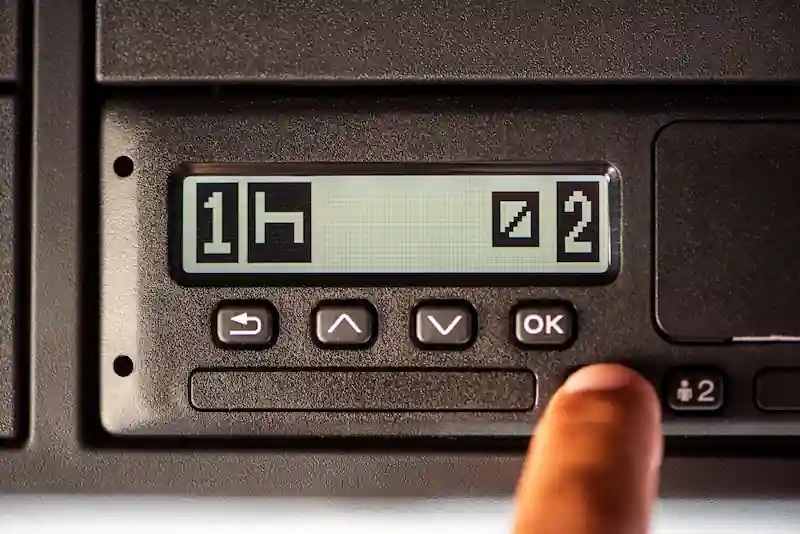Smart Tachograph 2: New obligations by the end of 2025 – what fleet operators need to know

By the end of 2025 at the latest:
All vehicles already subject to the tachograph obligation must be equipped with a Smart Tachograph 2 (SMT2 / G2V2) when engaged in cross-border transport – regardless of whether they previously used an analogue or a digital device (version 1).
From 1 July 2026:
The tachograph obligation will be extended to vehicles over 2.5 tonnes gross vehicle weight (GVW), provided they are used in cross-border transport. This particularly affects courier and delivery vans.
Switching to the Smart Tachograph 2 by the end of 2025
From the end of 2025, the EU requires the retrofit to the Smart Tachograph 2. The aim is to make road transport more transparent and efficient to monitor – particularly in international goods and passenger transport.
The observance of driving and rest times is regulated internationally. The signatories of the European Agreement concerning the Work of Crews of Vehicles engaged in International Road Transport (AETR) have harmonised many provisions to improve safety in transport.
What is the Smart Tachograph 2?
 The Smart Tachograph 2 is the next generation of the digital tachograph. It introduces new features that are important for both transport companies and authorities:
The Smart Tachograph 2 is the next generation of the digital tachograph. It introduces new features that are important for both transport companies and authorities:
- Automatic recording of border crossings
- Logging of loading and unloading operations
- Improved positioning via GNSS (satellite navigation)
- Secure wireless communication for remote checks by authorities
- Enhanced IT security standards
- Compatibility with other digital systems, e.g. fleet management
These enhancements are designed to make manipulation more difficult, reduce inspection efforts and improve compliance with driving and rest times.
Who is affected?
 All vehicles already subject to the tachograph obligation must, in cross-border transport, be equipped with a Smart Tachograph 2 by the end of 2025 at the latest – regardless of whether they previously used a digital tachograph (version 1) or an analogue tachograph.
All vehicles already subject to the tachograph obligation must, in cross-border transport, be equipped with a Smart Tachograph 2 by the end of 2025 at the latest – regardless of whether they previously used a digital tachograph (version 1) or an analogue tachograph.
In addition, from 1 July 2026:
Vehicles over 2.5 tonnes GVW used in cross-border transport will also be subject to the tachograph obligation.
This particularly affects smaller vans in courier and delivery services that have not previously been covered by this requirement.
Fines for infringements
Failure to comply with the new rules can be costly:
- €250 fine for drivers if a valid driver card is missing, making inspection impossible.
- €500 or more fine for companies if they fail to comply with the legal obligation to archive driver card data.
Our solution: TSI Telematic supports you with the transition
With our digital tachograph solutions and automatic remote download you will meet all legal requirements – reliably, efficiently and future-proof. Our service portfolio includes:
- Automatic remote download of driver card and mass memory – directly from the vehicle, without time-consuming manual steps in the cab
- Legally compliant archiving of all tachograph data – audit-proof and GDPR-compliant
- Daily updated evaluation of driving, rest and working times
- A clear overview of driver activities, border crossings, infringements and remaining driving times
- Seamless integration with fleet management, route planning and vehicle tracking
- Our systems are SMT2-ready and already support all the requirements of the new tachograph regulation
Be prepared now – with TSI Telematic Services
 Take this opportunity to bring your fleet up to date technically and organisationally. For many fleets this transition not only means replacing tachographs but also adapting internal processes, e.g. data archiving or training. With TSI you are already prepared for the new requirements – all in one portal, in a central place. We take care of the technical details for you.
Take this opportunity to bring your fleet up to date technically and organisationally. For many fleets this transition not only means replacing tachographs but also adapting internal processes, e.g. data archiving or training. With TSI you are already prepared for the new requirements – all in one portal, in a central place. We take care of the technical details for you.
Not sure whether your fleet is affected or which devices you need?
Contact us today for non-binding advice or a tailored offer. Our experts will advise you individually on the retrofit to Smart Tachograph 2 and the integration into your existing telematics solution.
Legal basis
The legal framework can be found in the following official regulations:


 Deutsch
Deutsch